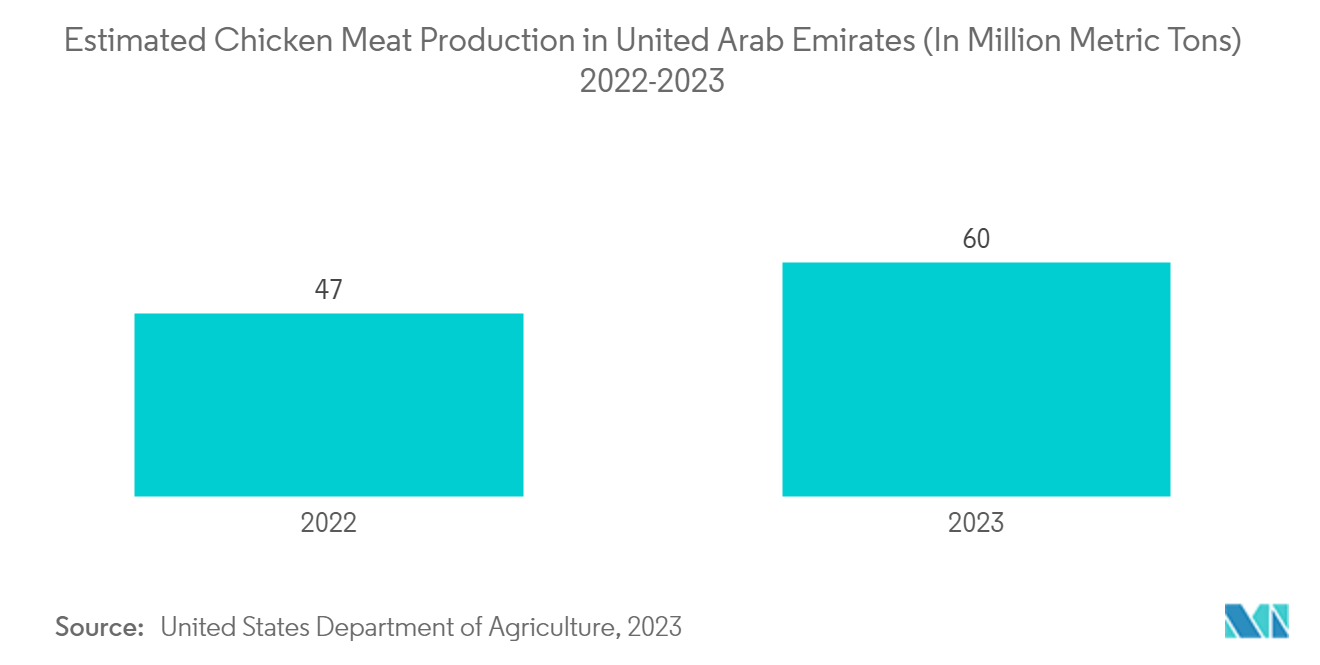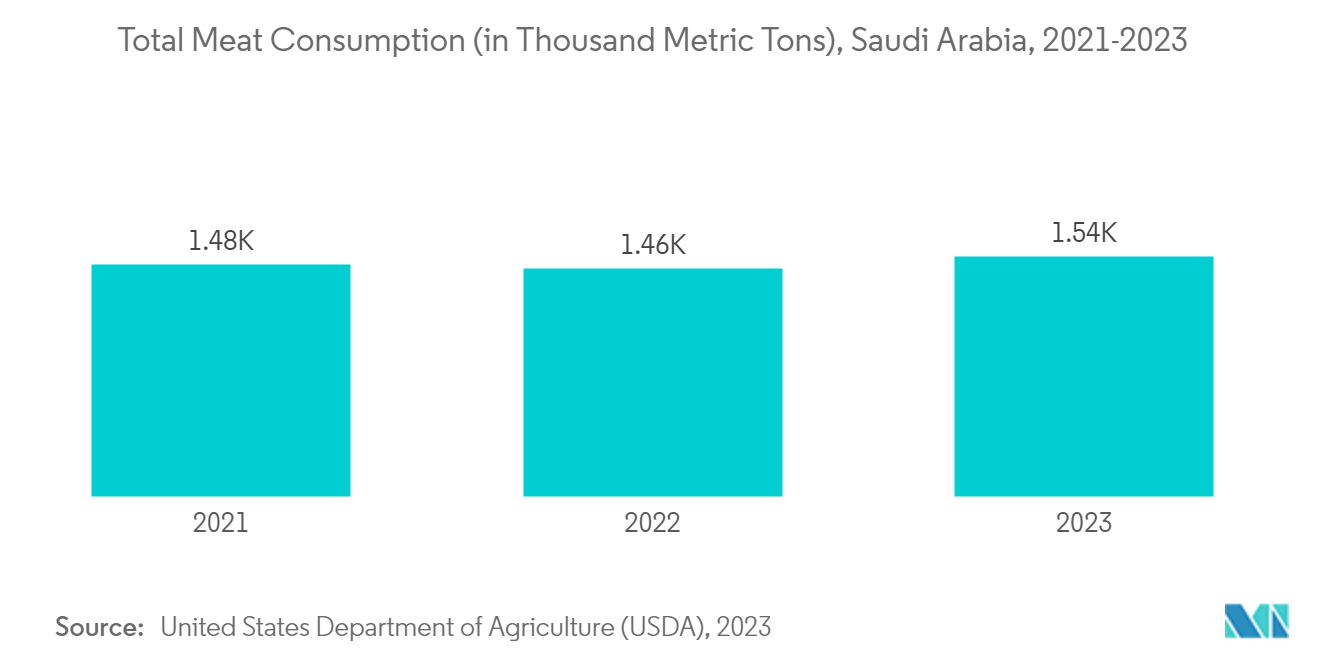Market Trends of Middle East And Africa Animal Genetics Industry
The Poultry Segment is Expected to Show Significant Growth Over the Forecast Period
The major factors driving the growth poultry segment in the MEA animal genetics market include the rising prevalence of avian influenza, Newcastle disease, increased poultry product consumption like meat and eggs, and various initiatives taken by prominent players.
The prevalence of highly pathogenic avian influenza (HPAI) outbreaks, such as those observed in Nigerian poultry, underscores the importance of genetic selection for disease resistance. Farmers and breeders are likely to seek poultry genetics that exhibit greater resistance to avian influenza, contributing to the demand for such genetics in the market. For instance, according to the study published in the MDPI Journal in May 2023, Nigerian poultry farms were exposed to the highly pathogenic avian influenza (HPAI) virus, and during 2022, HPAI caused 467 outbreaks in 31 of the 37 administrative regions in Nigeria. Thus, the high prevalence of HPAI amongst poultry in the region is projected to drive the demand of animal genetics during the forecast period.
In addition, the high prevalence of Newcastle disease (ND) in unvaccinated backyard poultry in Africa is a significant concern. This could drive the demand for poultry genetic testing with inherent resistance to ND. Breeders may prioritize genetics that exhibit resistance to this disease, thereby bolstering the poultry genetics market. For instance, according to the study published in Online Journal of Animal and Feed Research in May 2023, the prevalence of Newcastle disease among chickens in Maradi and Zinder regions of Nigeria was 18.6%. Thus, the high prevalence of ND in the region is also set to drive the market growth during the forecast period.
Furthermore, the growing consumption and production of poultry meat and eggs in countries like Egypt and South Africa create a greater need for genetics that ensure the health and productivity of poultry flocks. Genetics that offer traits such as rapid growth, high egg production, and disease resistance become vital for meeting the rising demand for poultry products. For instance, according to the United States Department of Agriculture in November 2022, Egypt was ranked at the 12th position in the chicken meat production with total production accounted for 1.85 million metric tons during 2023-2024, represented 1.8% of global production. Similarly, according to the United States Department of Agriculture Report published in September 2022, chicken meat production will increase by 28% in the United Arab Emirates in 2023, reached 60,000 metric tons. Thus, significant production of poultry meat is expected to contribute to the market growth.
Therefore, the factors such as rising prevalence of avian influenza, Newcastle disease, increased poultry consumption, and various initiatives taken by prominent players are projected to enhance poultry segment growth during the forecast period.

GCC is Expected to Hold a Significant Share of the Market Over the Forecast Period
The Middle East and Africa Animal Genetics market in The Gulf Cooperation Council (GCC) is expected to register significant growth during the forecast period owing to the increasing burden of diseases in animals and growth in poultry production and consumption.
The increasing burden of poultry diseases in Saudi Arabia, such as Infectious Bronchitis Virus (IBV) in poultry, is likely to drive the demand for genetics that offer disease resistance. Poultry genetics that exhibit resistance to zoonotic diseases become essential in mitigating the impact of such diseases, leading to increased adoption in the market. For instance, according to the study published in Springer Journal in August 2022, Infectious bronchitis virus (IBV) was repeatedly reported in poultry in Saudi Arabia, and several IBV genotypes were detected even in the presence of active vaccination programs in Saudi Arabia. Thus, the high prevalence of IBV in GCC is projected to drive the demand for animal genetics to combat its different genotypes, which is likely to drive market growth during the forecast period.
In addition, the growth in poultry production and consumption in Kuwait indicates a thriving poultry industry. As the Kuwait's poultry sector expands, there will be a greater need for genetics that optimize production, improve meat quality, and enhance disease resistance. This increased demand for genetics is expected to fuel market growth in the GCC region. For instance, according to the data published by United States Department of Agriculture in November 2022, Kuwait poultry production was 61,000 metric tons in 2023 which was increased by 2% from production of 60,000 metric tons in 2022. Thus, increase in the poultry production will lead to rise in the demands for animal genetics testing services, contributing to the market growth in the region.
Furthermore, Saudi Arabia's substantial investment in poultry production, aiming for self-sufficiency, is poised to boost the market. Increased poultry production translates to a higher demand for genetics that can accelerate growth rates, improve feed conversion efficiency, and ensure disease resistance in poultry flocks. For instance, in July 2022, Saudi Arabia announced its investment of SR17 billion USD 5 billion to boost poultry production in the country to achieve a poultry meat self-sufficiency rate of 80 percent by 2025. Hence, increasing production and consumption of poultry meat is expected to contribute to the market over the forecast period.
Moreover, the favorable government scenario in the country is also projected to drive the market growth in the region during the forecast period. For instance, in September 2023, The King Abdulaziz Arabian Horse Centre planned to introduce DNA tests to prove animal lineages in Saudi Arabia. The genetic testing project for pure Arabian horses will use DNA tests to prove their lineage and register and document species. Thus, the introduction of DNA tests to verify Arabian horse lineages in Saudi Arabia will likely boost the animal genetics market in the GCC by increasing demand for genetic testing services and products, as it sets a precedent for enhanced lineage documentation and breeding quality assurance.
Therefore, factors such as the increasing burden of zoonotic diseases and growth in poultry production and consumption are projected to drive market growth in GCC during the forecast period.


